
* The final design descendant of the MiG-15 was the USSR's first operational supersonic fighter, the "MiG-19". It would be the least prominent of the family and have a relatively short life in Soviet service, though the Chinese would prove more enthusiastic about the type and continue to build it as the "J-6" for much longer.
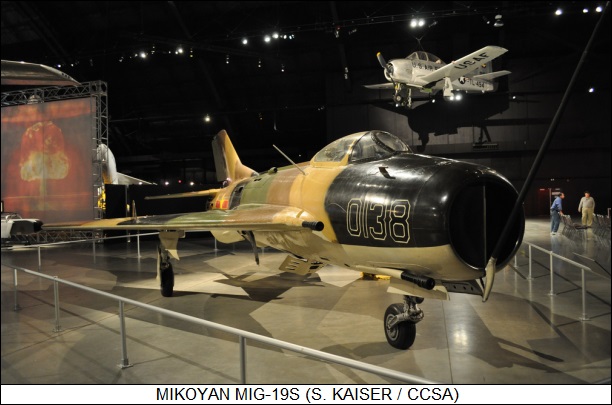
* Even as the MiG-17 was going into service, the MiG OKB began to work in earnest on a next generation of fighters that could attain Mach 1 in level flight. The first attempt, the "izdeliye M" or "I-350", was a bold move forward, featuring a wing with a sweepback of 60 degrees plus tail surfaces with a similar radical sweepback, and a new Lyulka TR-3A / AL-5 axial flow turbojet engine. The I-350 was to retain the armament of the MiG-15 and MiG-17, consisting of a single 37-millimeter cannon and two 23-millimeter cannon.
Two prototypes in an interceptor configuration were planned, one with RP-1 Izumrud radar, the other with Korshun radar. The prototype with the Izumrud radar performed its first flight on 16 June 1951, with the engine failing immediately after take-off; the pilot managed to get the aircraft and himself back down one piece. Four more flights were performed until the authorities finally conceded that the AL-5 engine was going to need a lot more work, and the I-350 program was axed in August 1951. The second prototype was never completed.
* At the time, the MiG OKB was also working on the MiG-17 SM-1 / I-340 with twin AM-5F engines, described in the previous chapter. Its performance was good, but no great step ahead of the MiG-17's, and so the logical thing to do was to use the engine arrangement of the I-340 with steeply swept flight surfaces like those of the I-350. The result was the "izdeliye SM-2" or "I-360" long-range escort fighter, with development formally approved in August 1951.
The I-360 was effectively a new aircraft, though it might have leveraged off some MiG-17 assemblies. It was powered by twin AM-5F turbojets, each providing an afterburning thrust of 26.5 kN (2,700 kgp / 5,950 lbf), and armed with a single N-37D 37-millimeter cannon in each wing root. The armament was moved from the nose to the wingroots to reduce problems with engine intake gun gas ingestion, though it complicated maintenance compared to the neat cannon tray of the MiG-15/17. The wing had a leading-edge sweep of 60 degrees; the aircraft featured a ventral fin and, initially, a tee tail arrangement.
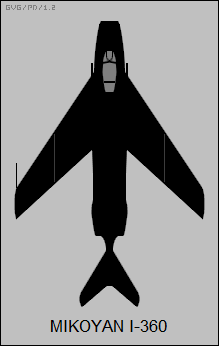
Two flight prototypes and a static test airframe were built. First flight of the initial I-360 prototype was on 24 May 1952, with test pilot G.A. Sedov at the controls; the machine broke Mach 1 in level flight on 25 June. The second prototype performed its initial flight on 28 September. The tee tail arrangement proved unsatisfactory, losing control authority at high angles of attack, and so a conventional tail arrangement was fitted, with a larger tailplane fitted at the base of the tailfin instead of the top.
* Performance of the I-360 was good, but the design suffered from a number of clear deficiencies. Although the VVS was enthusiastic about fielding the type, Mikoyan engineers thought they could do better and wanted to perform a major redesign, using the new Mikulin AM-9B / RD-9B turbojet, essentially an improved and scaled-up AM-5F with 25.5 kN (2,600 kgp / 5,730 lbf) dry thrust and 31.9 kN (3,250 kgp / 7,165 lbf) afterburning thrust. The new design was given the designation of "izdeliye SM-9".
A formal go-ahead for the development of the SM-9 was granted by the authorities in mid-August 1953, with both a tactical fighter and a radar-equipped interceptor to be built. Three SM-9 prototypes were built, with the initial flight of the first prototype on 5 February 1954, again with Sedov at the controls. Trials went well, though many changes were implemented during flight tests, with the third prototype approximating production specification. As was common Soviet practice, the type was ordered into production as the "MiG-19" in mid-February 1954, well before the trials were completed, with the VVS looking forward to the service's first true supersonic fighter. Both the second and third prototypes were lost in accidents in 1956, the pilot escaping unharmed in both cases.
The first two production MiG-19s were delivered to the VVS in June 1955, with 48 of the machines performing a flyover at the Tushino air show in August. NATO assigned the MiG-19 the reporting name "Farmer".
* As a footnote to MiG-19 development, as insurance the Mikoyan OKB built a parallel fighter design with a single Klimov VK-7 centrifugal-flow engine. The VK-7-powered fighter had flight surfaces like those of the SM-9 but a somewhat slenderer fuselage; it was given the designation of "izdeliye 1" or "I-370". The VK-7 engine encountered development programs and the I-370 prototype sat engineless for almost a year. When the engine finally became available, the engineers then had to iron out a long list of bugs in the airframe.
The I-370 did actually finally fly, initial flight being on 16 February 1955, with Mikoyan test pilot Fyodor I. Burtsev at the controls. Its performance was actually very good, particularly after it was refitted with an afterburning VK-7F engine, but even before the first flight both the VK-7 and I-370 had been axed. Centrifugal-flow engines were clearly not the way of the future for high-speed aircraft, and the test program was simply performed on inertia, as an experiment.
BACK_TO_TOP* The initial production MiG-19 was made mostly of aircraft aluminum alloy. It had strongly swept mid-mounted wings; a conventional swept tail assembly with a forward tailfin fillet; and a ventral fin under the tail. The control surface arrangement was conventional, with a single flap under each wing inboard of a prominent wing fence and outboard ailerons. The tail featured conventional rudder and elevators. There were twin dive brakes under the fuselage behind the wing. All internal fuel was carried in four fuselage tanks; there was no room for tanks in the thin wing. The rear fuselage could be pulled off just aft of the wingroots to expose the twin RD-9B turbojets for servicing.
All assemblies of the tricycle landing gear had single wheels, with the nose gear retracting forward and the main gear hinging in the wings to retract towards the fuselage. There was a small rubber bumper just aft of the ventral fin to protect the tail in case of "over-rotation" on take-off. A brake parachute was stored under the tail.
Built-in armament consisted of three NR-23 23-millimeter cannon, one in the right underside of the nose and one in each wing root. There was a small blast panel on each side of the fuselage to protect the aircraft from the muzzle blast of the wingroot cannon, though it seems that this panel was not included on all production. There was a stores pylon under the middle of each wing that could be used to carry bombs or rocket pods but, as far as the photographic evidence shows, usually carried a 760-liter (200 US gallon) external tank. Two pylons could be fitted inboard of the external tank pylon on each wing for carriage of unguided rocket pods, giving a typical external load for a ground attack mission of two external tanks and four rocket pods.
The pilot sat on an ejection seat under a rearward-sliding canopy. The cockpit featured armor plating and an armor glass windscreen. Standard avionics included radios, IFF, gyromagnetic compass, radio automatic direction finder, instrument landing system, radar-assisted gunsight, and a Sirena-2 RWR. One interesting feature was the long nose pitot probe fitted to the bottom lip of the engine intake, with the probe hinging upward on the ground so people wouldn't walk into it.
* The MiG-19's performance was excellent, with Russian sources claiming it had the edge in almost all respects over its contemporary rival, the US North American F-100 Super Sabre. However, the MiG-19 didn't get off to a good start with Red Air Force pilots, since it had an unfortunate tendency to explode in mid-air. The problem was finally traced to a fuel tank placed under the engines that could cook up when the engines overheated. A heat shield was inserted, but pilots remained unhappy with the MiG-19's handling. It landed too "hot"; had a nasty tendency to pitch up when the airbrakes were deployed; and was a beast to keep flying straight at high speeds.
Many of these deficiencies had been recognized during flight trials, but since the aircraft had been rushed into production before testing was complete, they had to be fixed in service. An improved version of the fighter, the definitive "MiG-19S", was introduced into manufacturing in 1956. It was given the NATO reporting name of "Farmer-C" -- the "Farmer-B" is described later.
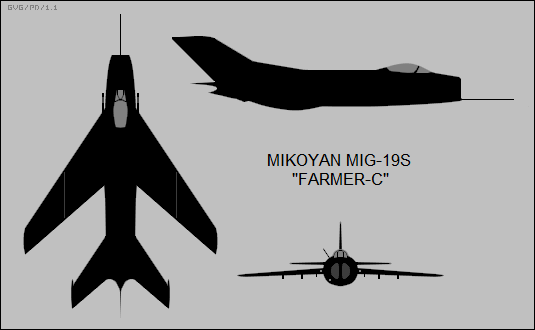
The MiG-19S featured tweaks overall, particularly in the form of a larger tailfin fillet to improve directional stability; an "all moving" or "all flying" slab tailplane, with small anti-flutter weights on the tips that gave it a distinctive barbed appearance -- these barbs would become a common feature on Soviet high-performance aircraft of the era; a third ventral airbrake just behind the ventral fin; and a range of small aerodynamic modifications. There were a few avionics improvements, including a new radio, improved gunsight ranging radar, and a "Svod (Dome)" long-range air navigation system receiver. Although early MiG-19S production retained the three NR-23 cannon, most were built with three much more formidable NR-30 30-millimeter cannon with muzzle brakes. Larger blast panels were fitted to the sides of the fuselage to protect the aircraft from the muzzle blast of the wing cannon.
MIKOYAN MIG-19S: _____________________ _________________ _______________________ spec metric english _____________________ _________________ _______________________ wingspan 9.2 meters 30 feet 2 inches wing area 25 sq_meters 269.1 sq_feet length 14.9 meters 48 feet 10 inches height 3.88 meters 12 feet 9 inches empty weight 5,760 kilograms 12,700 pounds MTO weight 10,000 kilograms 22,000 pounds max speed at altitude 1,540 KPH 955 MPH / 830 KT service ceiling 17,900 meters 58,725 feet combat radius 685 kilometers 425 MI / 370 NMI _____________________ _________________ _______________________ Combat radius is with drop tanks.
Pilots were still not very happy with the MiG-19S, since it was prone to hydraulic failures and inflight fires. These were generally due to manufacturing and not design defects, but they took some time to work out, and the type retained its bad reputation among pilots.
* A small number of MiG-19S machines were built in a reconnaissance configuration, with the fuselage cannon replaced by a camera payload. These aircraft were given the designation of "MiG-19R" and featured uprated RD-9BF-1 engines, with about 10% more dry thrust and an improved afterburner system. Late-production MiG-19S fighters were also built with RD-9BF-1 engines, with these aircraft designated "MiG-19SF".
BACK_TO_TOP* As mentioned, the development go-ahead for the MiG-19 also specified the design of a radar-equipped interceptor variant, work proceeding in parallel with development of the tactical fighter variant. The first of three "SM-7" prototypes of the interceptor variant performed its initial flight on 28 August 1954, with V.A. Nefyodov at the controls.
The SM-7 featured a redesigned and longer nose with RP-1 Izumrud radar and the fuselage 23-millimeter cannon deleted, the two wing cannon being retained. As with the MiG-17P/PF, the Izumrud featured a search radar in a "fat lip" radome and a tracking radar in a radome on the inlet bulkhead. The pitot tube was relocated to the right wingtip. The cockpit was larger to accommodate the radar display and control systems. After trials, the interceptor variant entered production in 1955 as the "MiG-19P" and went into service mostly with the PVO -- though the VVS and even the Red Navy operated a number of them. It was assigned the NATO reporting name of "Farmer-B".
Aside from the new radar nose, revised cockpit, and deletion of the fuselage cannon, the MiG-19P was similar to the MiG-19S, with the long tailfin fillet and all-moving tailplane. It was a bit draggier than the MiG-19S and performance suffered slightly; Soviet pilots had not been all that happy with the MiG-19S, and they were in general even less happy with the MiG-19P -- not merely because of the slight degradation in performance, but also because the view from the radar-equipped cockpit was substantially worse, and because of the unreliability of the radar.
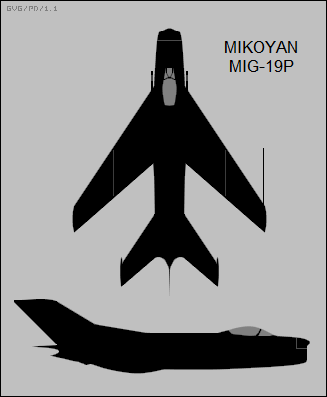
Early production MiG-19Ps had NR-23 cannon, but production then moved to NR-30 cannon. "Farmer-Bs" often carried a single unguided rocket pod under each wing for air-to-air attacks. Late in their service lives, some MiG-19Ps were modified to carry the K-13 / AA-2 Atoll Sidewinder AAM clone on a new outboard pylon. Late production machines had the improved RP-5 Izumrud radar, with greater range and better reliability. A number of MiG-19Ps were fitted with the Gorizont-1 ground-control datalink, which provided guidance information to direct a fighter to a target, and were redesignated "MiG-19PG".
* AAMs were seen as the future for fighter combat in the mid-1950s, and in 1956 work began on a missile-armed variant of the MiG-19P. Two of the MiG-19P prototypes were modified for trials, and the new variant entered service in 1957 as the "MiG-19PM". The variant was assigned the NATO reporting name of "Farmer-E" -- there doesn't seem to have been a "Farmer-D".
The MiG-19PM was very similar to the MiG-19P, except that the cannon armament was removed, to be replaced by four K-5M / RS-2 / AA-1 Alkali beam-riding missiles. The RP-1 Izumrud radar was upgraded to the PR-2U variant, which provided control capabilities for the AAMs. The MiG-19PM was even more disliked than the MiG-19P, since the draggy missiles cut into performance substantially, and the K-5M AAMs were nothing to write home about as armament.
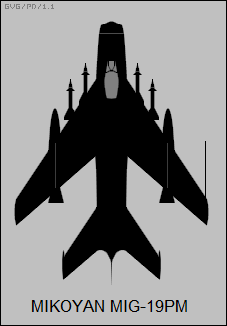
A few MiG-19Ps were modified to a MiG-19PM standard, though these aircraft could only carry two AAMs. A number of MiG-19PMs were fitted with the "Lazur (Prussian Blue)" ground control datalink in the 1960s. These modified machines were redesignated "MiG-19PML".
* The thread of dissatisfaction with the MiG-19 in Soviet service seems to have been due to pushing a substantially advanced, next-generation aircraft into operation in a great hurry. Under such circumstances, the MiG-19 was unlikely to be anywhere near as robust as the evolved, much more thoroughly debugged MiG-17. To be sure, the Soviets were nothing if not methodical and were often good about hammering a buggy system into shape, sometimes ending up with machines that were about as reliable as a shovel, but the MiG-19 was so quickly outpaced by improved aircraft that it was phased out of production in the USSR without reaching such a level of maturity.
The MiG-19 appears to have been a basically sound design, with excellent performance, but was hobbled by implementation defects. As discussed below, the Chinese would effectively adopt it as their own, and acquire an enthusiasm for it not shown by the Soviets.
BACK_TO_TOP* The American attempts to use balloons to spy on the USSR led the Kremlin to task the Mikoyan OKB with developing a variant of the MiG-19 that could shoot down the balloons. Initial work focused on a lightened MiG-19S with reduced armament, no cockpit armor, no brake chute, and so on, fitted with uprated RD-9BF engines. The type was put into limited production in 1956 as the "MiG-19SV", with one piloted by N.I. Korovushkin achieving a world altitude record of 20,740 meters (68,044 feet) on 6 December 1956. A single "MiG-19SVK" that was similar but had a new, wider-span dogtooth wing was tested in 1957. It was only able to climb a few hundred meters higher than the MiG-19SV, and work on it was abandoned.
By this time, the US had obtained a much better reconnaissance platform than balloons, the Lockheed U-2 "Angel" spyplane, which could cruise over the USSR at altitudes beyond the reach of any Soviet fighter, including the MiG-19SV. The first overflight of the USSR by a U-2 was on 4 July 1956, US Independence Day, as if taunting the Soviets -- though in fact the Americans were surprised when Soviet radars spotted the machine, the belief being that the U-2 would be effectively invisible at its altitude to the radars the Soviets possessed. Shooting the U-2 down was a high priority, and so the Mikoyan OKB investigated fitting the MiG-19S with a liquid-fuel rocket booster. The result was the "MiG-19SU".
The liquid-fuel booster was carried as a pack on the belly. Ground clearance was narrow and so take-off rotation had to be shallow. The pack was self-contained, requiring only electrical and mechanical attachment connections to the aircraft, but some airframe reinforcement was needed to handle the thrust stresses. The rocket worked well as far as that went, but storable liquid propellants as a rule are corrosive and toxic, and storable fuel and oxidizer generally have the interesting feature of catching on fire spontaneously when mixed together. That made the rocket pack somewhat troublesome and dangerous to deal with.
The MiG-19SU could indeed reach the operating altitude of a U-2; the problem was that it couldn't really do very much once it did. At such altitudes, even the U-2, with its sailplane wings and light airframe, was barely aerodynamic, on the edge of stalling, and only the very best pilots could fly the thing. The MiG-19SU was about as aerodynamic and controllable as a brick once it reached such altitudes, and the turbojets were likely to flame out in the thin air. All a Red pilot could do was basically take a running jump up towards a U-2 from lower altitude, and hope he could score a few hits before the fighter reached the top of its arc and fell (or more likely tumbled) back down again. It must have been an exciting ride, however.
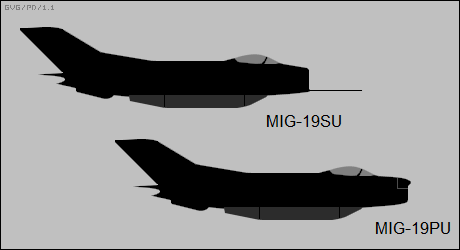
A number of MiG-19Ps were also built to carry the rocket pack, being designated "MiG-19PU". They weren't any more effective, and the real answer to the U-2 was the new high-altitude "S-75 Tunguska (NATO SA-2)" SAM. SA-2s finally shot down a U-2 on the appropriate date of 1 May 1960, the pilot, CIA operative Francis Gary Powers, being captured. US President Dwight Eisenhower, who had always had misgivings about the overflights, canceled them for good. The US was already working on a satellite reconnaissance capability and would soon be able to obtain photographic intelligence with a platform that the USSR had no immediate capability to shoot down.
Incidentally, both the US and the Soviet Union did work on anti-satellite systems, but the two sides realized that having strategic intelligence basically reduced tensions and tacitly "agreed" not to interfere with the satellites. The Soviets, with a long history of and talent for deception techniques, did put a good deal of effort into dummies and the like, even building inflatable submarines, to fool American spy satellites. Sometimes bored enlisteds would also pound out remarks or insults in the snow for the satellites.
* The MiG-19 also received the usual number of test and trial modifications. Some of the more interesting include:
* By the mid-1950s, Mikoyan engineers were working on a lightweight fighter to follow the MiG-19, with this concept emerging in a few years as the MiG-21 "Fishbed". Since the MiG-19 was still in production at the time, the designers decided to leverage the advanced "sharp-lipped" intake design of the new fighter into the older aircraft,
The result was the "SM-12" series of prototypes. Four prototypes were day fighter machines, performing flight trials in 1957. They were along the lines of the MiG-19S but with a MiG-21 day fighter nose, with a small intake cone. They featured a number of small airframe improvements; a varying fit of improved avionics; and Sorokin R3-26 turbojets, though not all four of the aircraft were fitted with the Sorokin engines at all times, retaining the AM-5F engines in some instances.
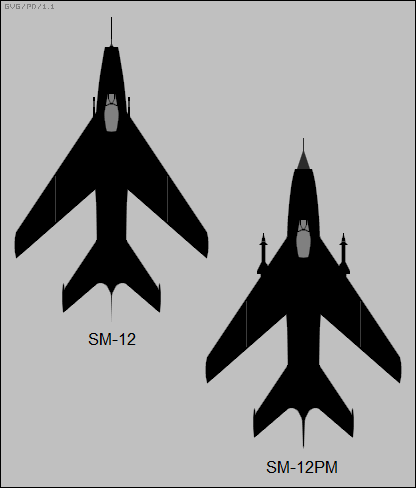
A single "SM-12PM" interceptor variant was flown in 1958, featuring a longer MiG-21 interceptor nose with a large intake cone containing the improved TsD-30 radar. The cannon were deleted and the aircraft was armed with twin AA-1 Alkali AAMs; it was fitted with R3-26 engines and had a variable exhaust. An "SM-12PMU" variant was also flown in 1958. This machine was very similar to the SM-12PM, but was fitted with the jettisonable liquid-fuel booster designed for the MiG-19SU/PU.
The SM-12s were interesting machines, looking something like hybrids of the MiG-19 and the MiG-21, which is effectively what they were. However, the MiG-21 was clearly such a step forward that it outclassed even an improved MiG-19, and so the MiG-19 faded into history as far as the Soviets were concerned.
BACK_TO_TOP* The Czechs built a relatively small quantity of MiG-19S day fighters at the Vodochody plant from 1958 into 1961, with these machines designated "Avia S-105". Only the airframes were actually built by the Czechs, with engines and other assemblies imported from the USSR. All S-105 production was retained for Czech service.
* The Red Chinese would take ownership of the MiG-19 from the Soviets, but the Chinese got off to a slow start. Initial efforts at license production focused on the MiG-19P interceptor, with the Shenyang factory obtaining knockdown kits of the aircraft from the USSR in 1958, with the first Chinese-assembled machine flying in December of that year. The first Shenyang-built MiG-19P or "J-6" flew in September 1959.
The Nanchang factory also worked on assembly and production of the MiG-19PM in parallel, with the aircraft to be designated "J-6B", but the whole effort at both factories then fell down. Chinese leadership wanted to advance the country faster, and began a national "Great Leap Forward" that was driven by revolutionary rhetoric instead of rational industrial planning. The results were a fiasco, with programs pushed ahead unrealistically until they all collapsed in chaos, accompanied by widespread famine due to agricultural dislocation. Specific details of the Chinese effort to build the MiG-19P and MiG-19PM during this time remain tangled and obscure; what isn't obscure was that the effort was a dismal failure.
After the collapse, Chinese industry picked itself up again and started over. Work on license-production of the MiG-19S day fighter at the Shenyang factory began in 1961, with the first Chinese-built machines flying at the end of the year. They retained the "J-6" designation.
Production began to ramp up over the next few years, despite the fact that relations between China and the USSR deteriorated so badly in the early 1960s that the Soviets yanked all their technical assistance. Unfortunately, just as production was getting on track in mid-decade, China then entered into another period of confusion, this time caused by Mao Zedong's "Great Proletarian Cultural Revolution", an attempt to radically restructure Chinese society along the lines of Chairman Mao's revolutionary ideals -- with China reduced to near-anarchy.
The production of the MiG-19S / J-6 managed to survive, and in the 1970s production ramped back up again. By that time it was basically an obsolete aircraft, but for the moment the Chinese didn't have the expertise to build a better one, and relations with the USSR remained frosty. The Shenyang factory built about 3,000 J-6s fighters into the 1980s, with large numbers exported under the designation of "F-6" to Chinese client states, particularly Pakistan.
In maturity, the type was apparently regarded as thoroughly rugged, the early bugs having been worked out through long experience. Total production included a number of subvariants:
The most distinctive Chinese-built variant was the "JJ-6" trainer, known as "FT-6" for the export market. As the J-6 became the standard day fighter for the People's Liberation Army Air Force (PLAAF), the MiG-17 derived JJ-5 became increasingly inadequate, and so work was performed to design a tandem-seat variant of the J-6C as a supersonic advanced trainer. It was strictly a Chinese aircraft; formally speaking, there was never a "MiG-19UTI".
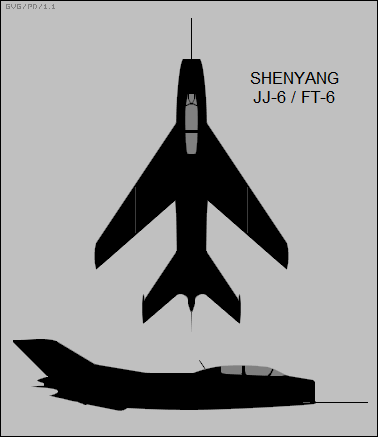
The fuselage was stretched 84 centimeters (33 inches) forward of the wings to accommodate the tandem-seat cockpit, which featured twin canopies that hinged open to the right. The wing cannon were deleted, but the fuselage cannon was usually retained; the single ventral fin was traded for twin fins.
Pakistan received a good number of FT-6 trainers, and in the 1980s set up a facility with Chinese help to refurbish them. The Pakistanis fitted their F-6s and FT-6s with Martin Baker Mark 10L rocket-boosted zero-zero (zero speed zero altitude) ejection seats. The Martin Baker seats not only improved safety, they also had a lower profile and gave more headspace in the cockpit. Another Pakistani innovation was fit of US-built AIM-9 Sidewinder AAMs on outer wing pylons. Pictures exist of the F-6 with this fit; it is unclear if the FT-6 was ever similarly equipped.
The F-6 is now out of production; while it appears to linger in service with Chinese client states, Chinese single-seaters have mostly been converted to drones -- not just target drones, but attack drones as well, capable of performing air strikes.
BACK_TO_TOP* As mentioned, the Chinese Nanchang factory did work on license-production of the MiG-19 early on. The Shenyang factory ended up building most of the F-6s, but Nanchang went on to build an interesting Chinese derivative of the MiG-19, the "Q-5", with the NATO reporting name of "Fantan".
Although the Chinese began casting about for a replacement for their piston-powered Ilyushin Il-10 Shturmovik attack aircraft in the mid-1950s, the program was effectively suspended for several years, not picking up steam until in the early 1960s. The MiG-19 / J-6 was the most advanced aircraft China was able to produce at the time, and so it seemed a reasonable basis for a dedicated attack aircraft. The first prototype Q-5 performed its initial flight on 5 June 1965. Production was delayed by the Cultural Revolution, but by the 1970s the type was in large-scale production, being exported to Albania, Bangladesh, Egypt, Iran, Iraq, North Korea, Pakistan, Somalia, Tanzania, Vietnam, and Zambia as the "A-5". It saw combat in the 1971 Indo-Pakistan War, and during the Iran-Iraq War in the 1980s.
The Q-5 used the rear fuselage and landing gear of the MiG-19 / J-6, but featured a new forward fuselage, with a "pointy" nose and side-mounted air intakes; the pointy nose was supposed to accommodate an attack radar, but the radar never materialized. The fuselage of the Q-5 was about 25% longer than that of the J-6. The wings were new, though they had the same sweep and general form-factor as the old, except for being "squared off" at the rear wingroot. Cannon armament consisted of a 23-millimeter cannon in each wingroot, a definite step back from the J-6.
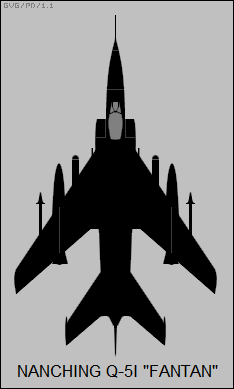
The variant history of the Q-5 remains obscure, but the initial production machine apparently had an internal weapons bay, and there were rumors of a variant optimized for nuclear strike that retained the weapons bay. The initial production machine had three stores pylons under each wing, with the middle and outer pylons "wet", plus two stores pylons under the forward fuselage, for a total of eight stores pylons. Typical weapons included dumb bombs, cluster munitions, unguided rocket pods, plus heat-seeking AAMs for self-defense.
The initial Q-5 led to the extended-range "Q-5I" in the early 1980s. The internal weapons bay was replaced by a fuel tank and two more stores pylons were added under the rear fuselage, bringing the total up to ten. The Q-5I also had a rocket-boosted ejection seat, uprated engines, a J-6C-style brake parachute pod at the base of the tailfin, and a number of minor engineering tweaks. The Chinese Navy flew the Q-5I, with these aircraft carrying two torpedoes or C-801 antishipping missiles, similar to the French Exocet. Since antiship missiles usually need to be targeted by radar, it is possible that targeting was performed in cooperation with other platforms.
The Q-5I was followed in production in the mid-1980s by the "Q-5IA", which had two more stores pylons, one on each outer wing, for AAMs, as well as an improved fueling system and updated avionics, including a sighting system. It was designated the "A-5C" or "A-5III" for export. The "Q-5B" improved on the Q-5IA by adding an improved bomb / gun sight, a laser rangefinder, and radar warning receivers; this variant appears to be also referred to as the "Q-5II" or "Q-5C".
NANCHANG Q-5IA: _____________________ _________________ _______________________ spec metric english _____________________ _________________ _______________________ wingspan 9.68 meters 31 feet 9 inches wing area 27.95 sq_meters 300.9 sq_feet length 15.65 meters 51 feet 4 inches height 4.33 meters 14 feet 3 inches empty weight 6,375 kilograms 14,055 pounds MTO weight 11,830 kilograms 26,085 pounds max speed at altitude 1,190 KPH 740 MPH / 645 KT service ceiling 15,850 meters 52,000 feet combat radius 400 kilometers 250 MI / 215 NMI _____________________ _________________ _______________________ Combat radius is for a low-altitude mission at MTO.
The total external load of a Q-5 was an unspectacular 2,000 kilograms (4,400 pounds), and range was limited without external tanks. In addition, the avionics fit was basic by Western standards, and Chinese engines required overhauls far more often than contemporary Western engines. In compensation, the Q-5 was very cheap; it was also extremely sturdy and provided a smooth ride at low level, both big pluses for an attack aircraft. Pakistan was fond of the type, and as with their J-6s they refitted their A-5s with Martin Baker Mark 10 zero-zero ejection seats, and wired them for Sidewinders.
* In the late 1980s, the Chinese attempted to develop two improved variants of the Q-5. The first, the "Q-5M", was a collaboration with Aeritalia of Italy and was to feature the nav-attack and countermeasures suite of the Aeritalia-EMBRAER AMX light strike fighter. The second, the "Q-5K", was a collaboration with Thomson-CSF of France and featured a laser rangefinder in a chisel nose, a modernized cockpit, and a nav-attack system. The idea was to evaluate both variants and select one for production, but following the Tianemen Square massacre in 1989 an arms embargo was imposed on China, and the Chinese had to reconsider the exercise.
The "Q-5E" and "Q-5F" were apparently experimental variants -- leading to the final production variant of the Fantan, the "Q-5L", which was introduced in the late 1990s. It featured modernized avionics, the most noticeable being a distinctive small fairing under the nose for a laser rangefinder / spot tracker, and a strengthened fuselage pylon for a K/PZ-01H laser targeting pod. It could carry 250-kilogram (550-pound) or 500-kilogram (1,100 pound) laser-guided bombs, and presumably other Chinese-made smart munitions.
The very last variant of the Fantan, rebuilt from old Q-5D machines, was the "Q-5J", a two-seater with a tandem cockpit. It was intended to replace the old JJ-6 in the fighter trainer role, as well as for use in the fast forward air controller role. Such Q-5s as remain in service won't be flying much longer, except possibly as target drones.
BACK_TO_TOP* The MiG-19's service in Soviet colors was transitory and not very significant. The most "action" they saw was against Western snooper aircraft probing around or into the USSR's borders. Possibly one of the best-known encounters was on 1 June 1960, when MiG-19 fighters shot down a Boeing RB-47H electronic reconnaissance aircraft that was snooping around Archangel in the north, with four of the crew killed and two taken prisoner. The RB-47H was in international airspace, but the Soviets were annoyed at U-2 and other incursions over their territory and wanted to send a message to President Eisenhower; the two prisoners were released after Eisenhower left the presidency. There were other shoot-downs by MiG-19s well into the decade.
The MiG-19 didn't do so well against the Lockheed U-2. In 1957, a PVO MiG-19 pilot flying at the aircraft's ceiling spotted a U-2 flying far over his head. He reported the incident to the brass, who judged him a liar, and he ended up being transferred. However, it soon became obvious that he had been telling the truth, and MiG-19s spent years trying to take potshots at U-2s with absolutely no success. As mentioned, it was the SA-2 Guideline SAM that actually put paid to the U-2 with the shootdown on 1 May 1960 -- but to compound the humiliation, a MiG-19 was also shot down by an SA-2 during the incident, the pilot being killed.
The MiG-19 apparently was the mount of the Red Five flight demonstration team for a time, but the type was out of first-line service with the VVS and PVO by the end of the 1960s -- though it lingered in secondary service well into the 1970s. Of course, by the time the MiG-19 was out of Soviet service, it was still a mainstay of the Red Chinese, and saw a bit of combat in Chinese colors. Taiwanese aircraft were common adversaries. There was a big air battle between Red and Nationalist Chinese forces in 1967, with twelve J-6s taking on four Lockheed F-104 Starfighters. The MiGs got the worst of it, with two losses and no kills.
There are also tales of Chinese J-6s flying combat missions during infrequent border squabbles with the Soviets, though with no records of dogfights; and of encounters during the Vietnam War with US aircraft that strayed into Chinese airspace. These confrontations resulted in a few shootdowns of Americans and, it seems, no losses of Chinese planes, though the MiGs sometimes had to make a hasty retreat back into Chinese airspace when the Americans called in reinforcements.
F-6s were supplied to North Vietnam late in the war, though the type didn't see much action compared to the MiG-21 and particularly the MiG-17. North Vietnamese F-6s did perform a few dogfights in 1972, the last year of the real air war. It threw a curve at the Americans, being more agile than the MiG-21, but having better performance than the MiG-17.
Cooperation between Chinese and Vietnamese is unusual, the two peoples having bitter animosities between each other measured in centuries, and after the end of the Vietnam War relations reverted to their traditional surly status quo. In 1979, China performed a punitive military incursion into Vietnam in protest of Vietnam's invasion of Cambodia. The operation did not go all that well for China, since the Vietnamese were thoroughly prepared for it, and at least one J-6 was shot down.
* The MiG-19 saw some combat in the Middle East, with Egypt obtaining their first batch in 1958 and Syria receiving the type beginning in 1962. Egyptian MiG-19s saw some action in the ground-attack role in support of revolutionary forces during the civil war in Yemen during the early 1960s. The first reported air combat in the Mideast with the MiG-19 was on 29 November 1966, when two Egyptian MiG-19 fighters tangled it up with two Israeli Mirage IIICs. The Israelis claimed two kills and no losses to themselves.
Many MiG-19s were in service with Egypt and Syria during the Six-Day War in 1967, but most were destroyed on the ground, and those that did survive were blown out of the sky by Israeli air superiority. Despite the unequal contest, Israeli pilots did find the MiG-19 a potentially dangerous adversary because of its performance, maneuverability, and heavy armament.
The Iraqis obtained some MiG-19S fighters in the early 1960s, but later sold them off; some did see action against the Kurds in the 1970s. In 1983, during the Iran-Iraq War, the Iraqis obtained a batch of F-6s through Egypt, while the Iranians acquired a batch of their own F-6s. Neither side made much use of them during the conflict, and there are no records of MiG-on-MiG dogfights.
The most significant combat seen by the MiG-19 was during the Indo-Pakistan War in December 1971. The Pakistanis claimed that their F-6s shot down about ten Indian aircraft, with a loss of four F-6s. Of course, the Indians maintain that the Pakistani claims for kills are inflated and the number of losses are understated. In any case, the Pakistanis felt the F-6 had acquitted itself well and expanded their fleet. During the Afghan War, Pakistani F-6s would scramble to deal with incursions of Soviet and Afghan aircraft into Pakistani airspace. The intruders were often in "hot pursuit" of Mujahedin guerrillas who were trying to escape back to their sanctuaries in Pakistan; since it was an open secret that the Pakistanis were supporting the Mujahedin, sometimes the intruders didn't feel like leaving when they were challenged, and there are tales of wild air battles. The Pakistanis didn't retire the F-6 until 2002.
* The F-6 was supplied to a number of African nations. Tanzania flew the type against Uganda during the war between the two states in 1978 and 1979, while the Sudan used it against separatists in southern Sudan, with at least one shot down. The Somalis flew the F-6 against rebels and the Ethiopians in the 1980s, though with the breakdown in civil order in Somalia all their aircraft ended up derelict by the early 1990s.
Although the MiG-15 and MiG-17 are both well-represented in the private warbird circle, it is difficult to find any MiG-19s or F-6s in private hands. No doubt the relative expense of operating and maintaining the type would make it too extravagant for all but the most prosperous of warbird pilots.
BACK_TO_TOP* One particularly interesting experimental use of the MiG-19, mentioned above, deserves to be discussed in detail. During the Cold War, the Americans tinkered with launching nuclear-armed strike fighters off of trailers using oversized booster rockets, the idea being the "zero-length launch (ZELL or just ZEL)" scheme being to disperse the aircraft so they could survive a first strike and retaliate. As was typical of the Cold War, what the Americans would do, the Soviets would often do in response, and the reverse -- and so the Soviets performed ZEL experiments of their own, using the MiG-19.
The Soviet motivation was different, however. Instead of dispersing nuclear-armed strike aircraft, the Soviets wanted to launch air-defense interceptors from remote locations and forward battle areas. Development of a trailer-launched MiG-19 system was approved in 1955. The result was a specially-built version of the MiG-19, designated the "SM-30". The SM-30 was reinforced to allow it to tolerate the stresses of rocket-boosted take-off, incorporated a special headrest to protect the pilot from whiplash, and replaced the single ventral fin of the MiG-19 by a pair of fins straddling a PRD-22 solid-fuel booster, which generated about 578 kN (59,000 kgp / 130,000 lbf) of thrust.
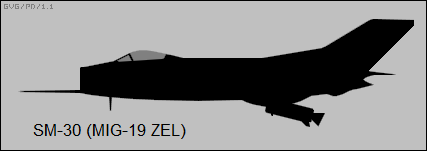
The SM-30 was transported to a remote site on a large trailer, and then placed on a separate trailer for launch. A trench had to be dug behind the trailer to contain the exhaust, which would otherwise kick up a cloud of debris that would be visible from far away. The aircraft was secured to the launch rail by bolts that would, in principle, shear when afterburner was engaged.
The first test launch, using a remote-controlled SM-30, was conducted in the fall of 1956. The launch went smoothly, but the launch trailer was wrecked, and so a blast shield was devised. The first piloted launch was in April 1957, with test pilot Georgiy M. Shiyanov at the controls. Shiyanov had trained for the launch on a special launch simulator catapult, enduring 18 gees on one test when the technician arming the catapult made an error. Shiyanov suffered no real harm from the incident; sources make no mention of any consequent injury to the technician.
As with the American ZEL efforts, launches proved surprisingly easy. Landings were a bit trickier. The standard drag chute for the MiG-19 wasn't adequate for the rough forward-based landing strips envisioned for the ZEL fighter; an arresting-cable scheme was implemented and partially tested.
The tests were terminated when the Soviet government lost interest in the concept, for reasons somewhat similar to those that killed the American ZEL project. The requirement for a landing strip reduced the attractiveness of ZEL -- it would be simpler in that case to just take off from the strip, using standard RATO rockets -- while attempting to transport such a big and bulky system across the countryside was difficult, particularly when confronted by obstacles such as tunnels. The development of effective battlefield surface-to-air missiles proved to be a much more workable solution to the problem of forward air defense, and the Soviet ZEL went nowhere.
BACK_TO_TOP* I started out on this document intended to focus on the MiG-15, with some intent to add the MiG-17 if I got the time. As usual, the work got out of control and I ended up doing the MiG-19 as well. American fighters pilots in Korea and Vietnam would get "MiG fever", a strong itch to score a kill on a MiG. After two months of tinkering with the subject, I acquired a taste of "MiG nausea". I had to lay off for a while.
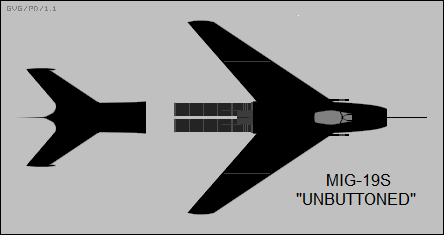
* As concerns copyrights and permissions for this document, all illustrations and images credited to me are public domain. I reserve all rights to my writings. However, if anyone does want to make use of my writings, just contact me, and we can chat about it. I'm lenient in giving permissions, usually on the basis of being properly credited.
* Sources include:
* Revision history:
v1.0.0 / 01 apr 05 v1.0.1 / 01 nov 05 / Extensive typo corrections, minor tweaks. v1.0.2 / 01 nov 07 / Review & polish. v1.0.3 / 01 oct 09 / Review & polish. v1.0.4 / 01 sep 11 / Review & polish. v1.0.5 / 01 aug 13 / Review & polish. v1.1.0 / 01 jul 15 / Added MiG-19 ZEL section. v1.1.1 / 01 jun 17 / Review & polish. v1.1.2 / 01 may 19 / Review & polish. v1.1.3 / 01 may 21 / Review & polish.BACK_TO_TOP
